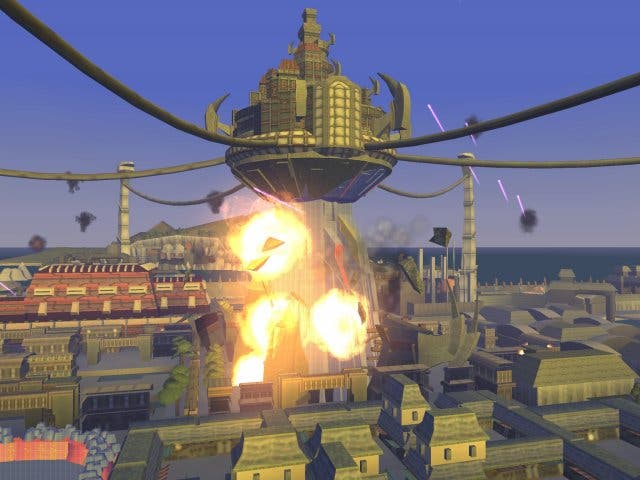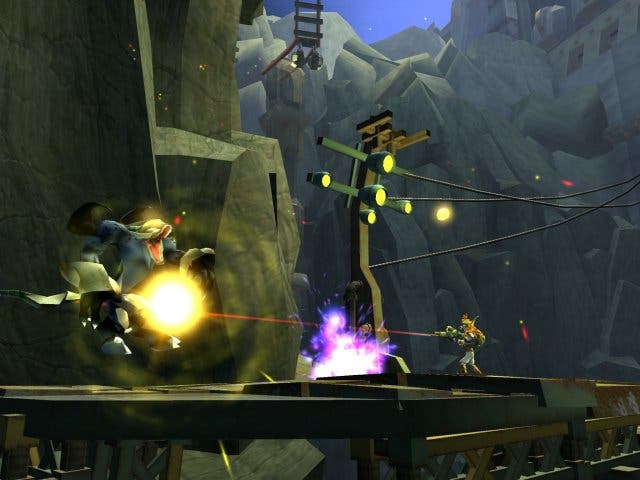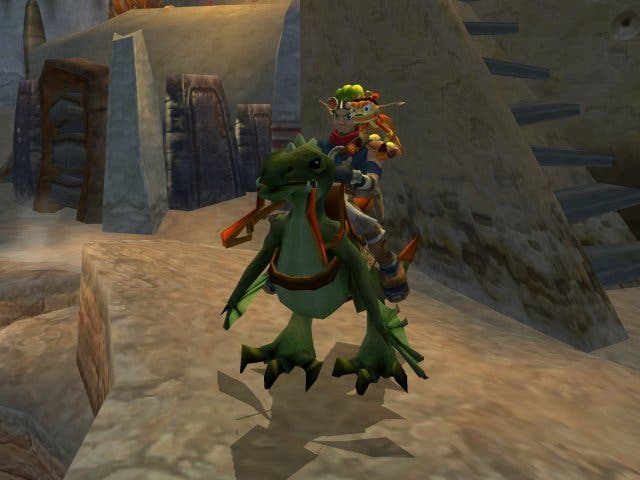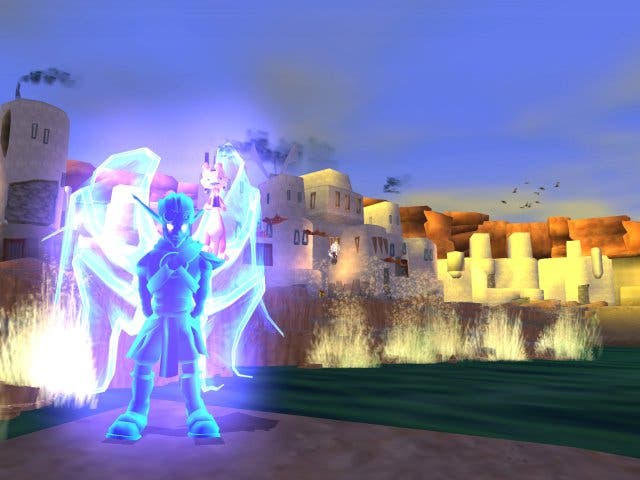Jak 3
The end of the line for Jak & Daxter?
We've found life in the desert. We've learned why Sig was in Haven City. We've found out who's behind the latest Metal Head incursions. We've met the precursors. We've unmasked Mar. After nearly 40 hours in front of Naughty Dog's trilogy of PS2 platformers, we have said goodbye to Jak and Daxter, and although the developer insists that it hasn't closed the door on the multi-million-selling duo, it's difficult to see how any further tales from Jak's world could muster the same gravitas. There are no more mysteries. This is the end. And it's not quite the end we expected.
Boing

Jak used to jump around a lot more. In the heavily GTA-influenced Jak II, he didn't do quite as much jumping around, but when he did it was sustained and memorable. Who can forget the passage across the very skyline of the city on the way to a showdown with the Baron? Or scrambling over vast precursor machines in the depths below Haven City? And how the game dipped its platforms in a melange of other genres - most notably shooting and hoverboarding - with almost blanket success?
But Jak doesn't jump around much at all these days. Instead, Jak 3 continues to feel the influence of GTA, increasing the emphasis on gunnery and story development, and also borrows heavily from another Rockstar game - bouncy dune buggy caper Smuggler's Run - to the extent that platforming has taken a back seat - and memorable run and jump sequences are all too brief and few and far between. Fortunately though, the pervading accessibility and entertainment that defined the series' best platforming and kleptomania remains intact - and for that reason, as much as the fact that it answers all the pertinent questions, Jak 3 is a near-essential purchase.
To clarify the story: At the outset, Jak finds himself ejected from Haven City along with pals Daxter and Pecker by a sinister bureaucrat named Veger, who along with the various members of the Haven City council blames Jak for the ongoing war with the Metal Heads and other dark forces - and the recent collapse of the palace, which flattened a good chunk of the city and bore a hole deep into the catacombs beneath it. But Jak still has friends, and recurring squeeze Ashelin gives him some sort of tracker beacon which sees our hero and his sidekicks picked up by Damas, ruler of the Wasteland city Spargus - and gives Jak another reason to prove himself to the populous before he can get back into the swing of the war for his home.
And for desert

Spargus is not as big or as varied as Haven City was, and in terms of design it's not that different either - the only real differences being a brighter palette and distinctive character designs, and transport via Yoshi-esque Leaper lizards rather than hover-cars - but the various tasks Jak tackles here are often far removed from anything we saw in Jak II. The on-foot arena shoot-'em-up sections, where Jak has to tackle a number of identikit goons to ensure progress, are distinctly Ratchet & Clank-esque, and the Leaper lizard race will come fairly naturally to fans, but things like the rhythm-action mini-game that opens up a dark precursor artefact, and the wide variety of buggy missions, demand decidedly different skills.
The addition of the Smuggler's Run-style sections makes a big difference to the overall thrust of the game, but fortunately they're imbued with the same satisfying mechanics and balance that Naughty Dog's platform missions typically are. Handling is very bouncy and buggy-like, each buggy can do a hop (one can even leap vast distances, and has to be used to access a temple in the mountains), each has a weapon of sorts for tearing up the local flora and rival buggy-riders, each can turbo-boost several times, and they all automatically right themselves when they go for a roll. Skidding around the desert shooting at enemies, and trying to win races, collect artefacts before your rivals (this being the most blatant lift from Smuggler's Run), play driver or gunner in Metal Head raids, and chase down a series of enemies having been ambushed in a lake-top arena, is all instantly accessible and good fun.
Out of the driving seat the game also controls well. Jak runs, jumps and double-jumps, can perform crouched and rolling jumps for extra height and length, can switch to his hoverboard once he's unlocked it (with the same range of tricks and turns), can pick from one of four weapons as he unlocks them, and can select and fire his chosen gun out of the usual four. There's been no real change in terms of mechanics here - certainly nothing to rival the leap from high-kicking platform mute to grizzled, gun-toting resistance fighter between games 1 and 2 - but at intervals Jak now unlocks a pair of upgrades for each of his four weapons, which allow you to tackle more enemies without having to target them individually, and afflict them with other problems that clearly draw inspiration from Insomniac Games' parallel Ratchet & Clank series.
Six-shooter in the City

Another change is that in addition to summoning his dark eco powers and becoming Dark Jak to increase his attacking capabilities, our hero can also now harness the power of the light side of eco and become Light Jak, allowing him to slow down time and even fly around at the behest of a pair of iridescent and distinctly angelic wings later on in the game. However it's fair to say that Naughty Dog asks much more from the weapons side of Jak's character than his manoeuvrability. Many missions are straightforward shoot-'em-up sections now, offering only half-hearted nods toward the sort of platforming that used to bind the series together, and on the whole you'd say the game feels more like a platforming Grand Theft Auto now than it feels like the first Jak & Daxter.
Technically it's no longer the seamless entity it once was. Now there are brief loading pauses at doors ala Jak II and the odd black screen transition to break up proceedings, and the world no longer holds the fascination that it did in the original game. You used to see something and then marvel at the journey to get there. Now there's very little that isn't within obvious distance of your hover-car, hoverboard, flapping wings or something else besides, and any distant areas of intrigue that are beyond them simply don't figure in proceedings. Eggs are hidden in alcoves now, rather than atop peaks. Even when you get back to Haven City around 40 per cent of the way into the game, the damage done by the collapsing palace is barely evident beyond a bit of surface destruction, and it isn't until the final hour or so that you start to delve into it and find yourself stumbling over the sort of post-apocalyptic ruins you'd expect to see in a Terminator film.
In this sense you could argue that the reuse of Haven City is a bit of a jip. Having wandered around the unremarkable Spargus for a few hours, it's distinctly underwhelming to be thrust back into the same recycled locations for mission briefings (the bar, the control room, etc) and asked to tear around the same port, the same streets, the same walkways and sewers, tackling the same enemies and new adversaries cut from the same mould. Even the old weapons training course with its pop-up KG units has been reused. And given that the (admittedly detailed) graphical tech is on much the same level as Jak II - certainly to the extent that we couldn't spot any obvious differences - from a spectator's point of view the game might well be shaping up disappointingly.
Reasons to be cheerful

However it is not a disappointment - and that's thanks to the consistently amusing and entertaining story, borne out in a sequence of cartoon-quality cut sequences that really are becoming Naughty Dog's forte, the quality of the missions themselves, and perhaps most significantly for fans of the second game a far more reasonable and considered difficulty curve.
In narrative terms the game is highly developed - Haven City remains in peril, under pressure on several fronts, and Jak and his band of merry freedom fighters not only have to worry about dealing with that, but also uncovering the secrets of the precursors to try and prevent an impending global catastrophe - and scupper the machinations of a couple of recurring villains. If there's a problem with the story it is only that you're often making such strong progress in the game itself that it seems to zip past in the blink of an eye, and memorable cut-scenes featuring the likes of Daxter and Pecker on top form are quickly forgotten. But in general it's destined to satisfy the fans and demystify the precursors as well it should do, and it does so in some style - with fantastic voice acting and brilliant animation to back up the exposition.
As for the missions, they really do touch on almost everything at least once, whether it's rhythm-action, Pac-Man, manning a gun turret, racing, escorting allies, or even aerial combat. There are many moments that we'll remember fondly - racing along a windy mountain path trying to fend off Metal Heads whilst shooting signal posts so that a mine cart laden with explosives stays on track; gunning through the lower levels of a factory and then stealing a buggy and ram-raiding our way to the top; and trying to escape a volley of heat-seeking rockets by tearing around the bay at full pelt and attempting to activate decoys to name but a choice few. There are times when the developer lazily slips into the "destroy five of these" groove, but on the whole these aren't too distracting; heck, they're fun in themselves, however clichéd.
Stop shouting

And it's all handled in such a way that it doesn't have you ripping your own arms off in frustration. The second game was notoriously difficult in places, so much so that Naughty Dog had to pledge to try and stamp out the difficulty spikes that dogged some sections of the game - like that flipping Krimson Guard fest in the slums, which almost sapped our will to live on about five hundred successive occasions. Not so Jak 3. Even the boss encounters are quite reasonable, and shouldn't stop you dead in your tracks for too long. There are a couple of shout-at-the-TV moments in there, but neither is fatal - although the second of them does expose a potential problem with occasionally nondescript mission objectives. All we'll say is "you can take over the instant-kill gun turrets in the forest". Not a spoiler, but we did just do you a favour. The rest of the game is just the right side of difficult, and the save point spacing is judged almost to perfection, and only starts to demand more of you as the game ramps up towards its conclusion. Which is just the way it should be.
All the same it's not without flaws of its own. For a start, the fact that you come to rely on the two weapon upgrades that kill things when you're facing the wrong direction ought to be warning enough that the third-person camera still has difficulty coping with complex gun combat - and your thumb gymnastics generally prohibit manual adjustment in battle. The same camera also exposes some perspective issues that sometimes lead to your fouling up relatively simple jumps, but thanks to the developer's sensible checkpoint policy you'll probably find neither the combat or the pitfalls are particularly depressing. Certainly not enough for you to give up.
Otherwise, our only gameplay-related complaint is that the GTA-style structure is over-exploited in terms of getting around and hosting missions, and under-used in terms of non-linear progression. Okay, Jak's games will never be as content-rich and diverse as a Grand Theft Auto game, but it'd be nice to see more options when you're moving on to the next mission. As it is the game is decidedly linear except on a couple of occasions when it splits your focus between Haven and Spargus, or north and south Haven, and the world lacks the sort of throwaway distractions that keep you interested when the missions in a GTA title rile you up.
The Precursor Legacy

What's genuinely disappointing though is that it's all over so quickly. Whether on account of the shorter dev cycle (Jak II took two years; Jak 3 just the one) or what, Jak 3 is much, much shorter than its epic predecessor. Indeed, it took us just 10 hours to achieve a 100 per cent rating, and although there are other things to go back and collect - eggs, Metal Head gems, and such - the benefits are unlikely to sway us to return to Haven City, having spent roughly a game and a half in its unflinching company.
And although we're definitely sold on what it does have to offer, it would be churlish of us not to observe that the balance has shifted away from precise, J&D-style platforming to the extent that it's barely a platform game any more. And some people will definitely feel the loss there more than others. In Jak & Daxter, missions were little rollercoasters that took you all over the place, into the heavens, under the earth, and dragged you from pillar right up to the top of the post you'd seen earlier and blurted "How on earth do I get there?" There's less to gawp at in Jak 3. There are still gasp-worthy moments, but they're fleeting, and on the whole it feels more like a collection of related tasks than the intricate, seamless acrobatic odyssey of the original.
But, as we said at the outset, the key point here is that whatever was fundamentally absorbing about Jak & Daxter and its controversial sequel has endured, and the areas that the series now focuses on have been brought to life with that same passion, and have that same attraction about them that keeps you glued to the pad. If you want platforming precision and a strong narrative, Prince of Persia may prove to be more closely aligned with your expectations and desires, but if you want to find out what happens to Jak and you're happy to shoot stuff and drive around more than you leap and collect, Jak 3 is bound to satisfy. Depending on your own particular bent it's either the weakest in a strong series or simply the most diverse, but whatever your view Jak 3 is a necessity for fans, and as pleasurable an experience as anything Naughty Dog has ever made. A fitting swansong to be fondly remembered.

